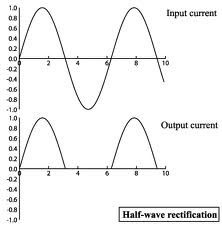If Ns is greater than Np, the transformer is called step-Up transformer.
If Ns is less than Np, the transformer is called step-down tranformer.
For Ns<Np, Vs<Vp and for Ns>Np , Vs>Vp.
If Ns=Np then it would be ideal transformer.
Improtant points about Half-Wave Rectification:

- Frequency of half wave pulsating DC voltage is equal to the frequency of input AC voltage. Therefore the half-wave signal has a period:
T=1/f, For 50Hz AC in Pakistan, the period is T=1/50=0.02sec
=20 millisec
This period can be seen measured on oscilloscope
The AC voltage at the transformer is in the ratio of the turns of secondary,Ns, to the turns of primary,Np. If this turn ratio is 5:1 and input. AC line voltage is Vp=220 v, then stepdown Vs=Ns/Np.Vp =1/5 x 220 = 44 volts.
- Vm=Vs - Vf
Im = Vs - Vf =44-0.7 = 43.3 volts
and peak load current is:
Im=Vm/(RL + RF)
RF and VF are smaller as compared to Vs and RL.
So, Im=Vs/RL - During the negative half-cycle, the reverse-biased diode offers a very high resistance so that only a very small reverse current IR flows through the load.
In This case,output voltage is
Vo= Ir x RL
For Practical purpose, we take this output voltage nearly zero.

- Average DC voltage. If we connect DC voltmeter accross RL,it will indicate a dc voltage, which is given by:-
Vdc =Vm/2pi(-cospi) = 0.318Vm - The average DC current:
the average dc current
Idc = Vdc/RL = Vm/pi x 1/RL=Im/pi - RMS current and Efficiency :
Efficiency= Pdc/Pin



